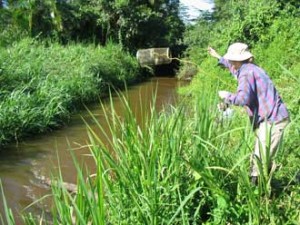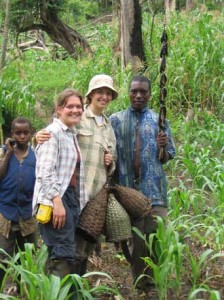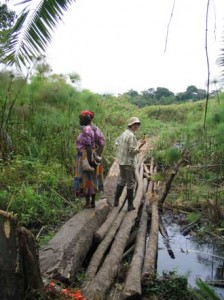
By Erika Crispo
We arrive at Uganda’s Entebbe International loaded with dissection kits, latex gloves, vials, oxygen meters, minnow traps, fish food – not items one would bring on a typical African safari. In fact, our journey is an even more adventurous one.
My lab-mates and I have gone to Uganda to study strategies used by fish adapting to low- oxygen conditions. The results have world-wide conservation implications – low-oxygen conditions, or hypoxia, are becoming critical in areas impacted by humans. It is imperative to understand how fish will respond to these changing conditions. A particular species of cichlid (pronounced “sick-lid”) fish, affectionately known by Ugandans as “blue lips” (because it has blue lips, of course), is a particularly fruitful species for study – it can be found in both high-oxygen rivers and adjacent hypoxic swamps. Hence, annual treks to Uganda to study this tiny fish.
We travel west to the headquarters of the Kibale Fish and Monkey Project at the Makerere University Biological Field Station in Kibale National Park. Along the way, we spot many men on bikes carrying matooki, which resemble green bananas but are cooked in stews. Within the borders of the park, we come upon a new medical clinic that has been established through the efforts of various researchers at McGill. The clinic had been built since our previous visit to the country, so we are stop to admire the facilities before continuing.
We soon reach camp and make ourselves at home. Our cabins are comfortable, with sofas for relaxing, desks for working, and bins to collect rainwater for cooking and washing. And of course, irons to press our clothes in order to kill the eggs of tiny flies, called mango flies, which lay eggs in damp clothes. The larvae burrow into human skin upon hatching and can cause illness if they occur in large numbers.

Once installed, we are reunited with our Ugandan friends. Emmanuel is a local villager who has worked as an assistant with the Kibale Fish and Monkey Project for several years. Patrick is a PhD student at Makerere University in Uganda, and has worked as the project manager.
Early next morning we set out to catch the blue lips. Our journey takes us on bumpy, winding roads past villages that dot the edges of the Mpanga River. Our work takes us to remote locations where foreign visitors are rare. As we drive, children chase the car, shouting “Mzungu! Mzungu!” the local word for “white person.” When we stop and wave at them, each responds differently – some are excited and run up to us, while others shy away.
Finally, our group reaches the river. Collecting fish at this spot is easy – we simply set minnow traps in the grassy edges of the river and wait. Emmanuel and Patrick buy a jackfruit, or “fenne,” to snack on. I opt to avoid the sticky, marshmallow-flavoured fruit. The nectar of jackfruit is so sticky the Ugandans apply petroleum jelly to their hands before eating it – soap and water is not sufficient to remove the stickiness from one’s hands.
After pulling the traps and loading the catch into coolers on the truck, we head to the swamp. Because the swamp is tricky to find, we stop frequently to ask directions.

At our destination, we have to cross precarious log bridges to reach the grassy sites the blue lips inhabit, all the while balancing heavy equipment and coolers to transport our catch. We set the traps and wait. Local fishermen admire our sturdy aluminum fish traps while we admire the fine handiwork of their banana-leaf traps. They show us the catfish, or “nsonzi,” which they caught in their traps, drying on a papyrus pole. Despite our modern equipment, we prove to be less lucky and our small catch of blue lips means we will have to come back another day.
Back at camp, we have a day off. I spend my time walking through the forest, keeping an eye open for monkeys. Kibale National Park’s tropical rainforest contains the highest biomass of non-human primates anywhere in the world. One must keep an ear out for elephants though – they are territorial and have been known to chase researchers. Luckily no one is injured this year. I also take time to visit the chimpanzee centre, part of the Kibale Chimpanzee Project, located within the park boundaries. Here, park officials have habituated one family of chimpanzees to tourists. What a fantastic experience to view the chimpanzees up close!
Finally, big rains come. Rain is good for catching fish, because it tends to stimulate dispersal. The next day, we are able to catch as many fish as we need. This will be my last visit to Uganda, but it was a fruitful one. I take with me memories that will last a lifetime.
Erika Crispo is a PhD candidate in Biology at McGill University. She works under the supervision of Dr. Lauren Chapman. Information about Makerere Biological Field Station in Kibale National Park can be found at http://www.arts.mcgill.ca/programs/anthro/chapman_files/kibale/index.html.
J
